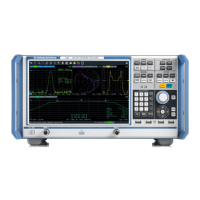Command Reference
R&S
®
ZNB/ZNBT
1117User Manual 1173.9163.02 ─ 54
Tip: The analyzer provides a default calibration corresponding to a test setup which
does not introduce any systematic errors; see [SENSe<Ch>:]CORRection:
COLLect:SAVE:SELected:DEFault.
For an overview of calibration methods and error terms refer to Chapter 5.5.1, "Calibra-
tion Types", on page 150.
G and H matrices
The 7-term calibration types named Txx (e.g. TOM, TRM, TRL, TNA) are based on a
network analyzer with two ports i and j, each equipped with a test receiver and a refer-
ence receiver. The system errors are described in terms of two "error two-ports" P
G
and P
H
:
●
The error two-port P
G
is assigned to port i of the analyzer. Its transmission matrix G
describes how the system errors modify the outgoing and incident waves at port i:
test i
ref i
2221
1211
i
i
m
m
GG
GG
a
b
●
The error two-port P
H
is assigned to port j of the analyzer. Its transmission matrix H
describes how the system errors modify the measured incident and outgoing
waves at port j:
ref j
test j
2221
1211
j
j
m
m
HH
HH
b
a
In the two equations above, a and b denote the waves at the calibrated reference
plane i and j (e.g. the input and output of the 2-port DUT). The m waves are the raw
measured waves of test port i and j. The subscripts "ref" and "test" refer to the refer-
ence and test receivers, respectively. During the calibration the network analyzer
acquires ratios of wave quantities, which leaves one of non-diagonal matrix elements
of G or H as a free normalization factor. The network analyzer uses the normalization
H
21
= 1.
Suffix:
<Ch>
.
Channel number of the calibrated channel.
<PhyPt> Physical port number, used to select a specific frequency axis in
arbitrary mode (with option R&S ZNB/ZNBT-K4).
Parameters:
<ErrorTerm> String parameters describing the different error terms, depend-
ing on the current calibration method; see table below. Each
term contains one complex value (real and imaginary part) for
each sweep point. The parameters must be transferred in full
length. The following strings are allowed:
'DIRECTIVITY'
Directivity at source port <SourcePort>
'SRCMATCH'
Source match at source port <SourcePort>
'REFLTRACK'
Reflection tracking at source port <SourcePort>
SCPI Command Reference

